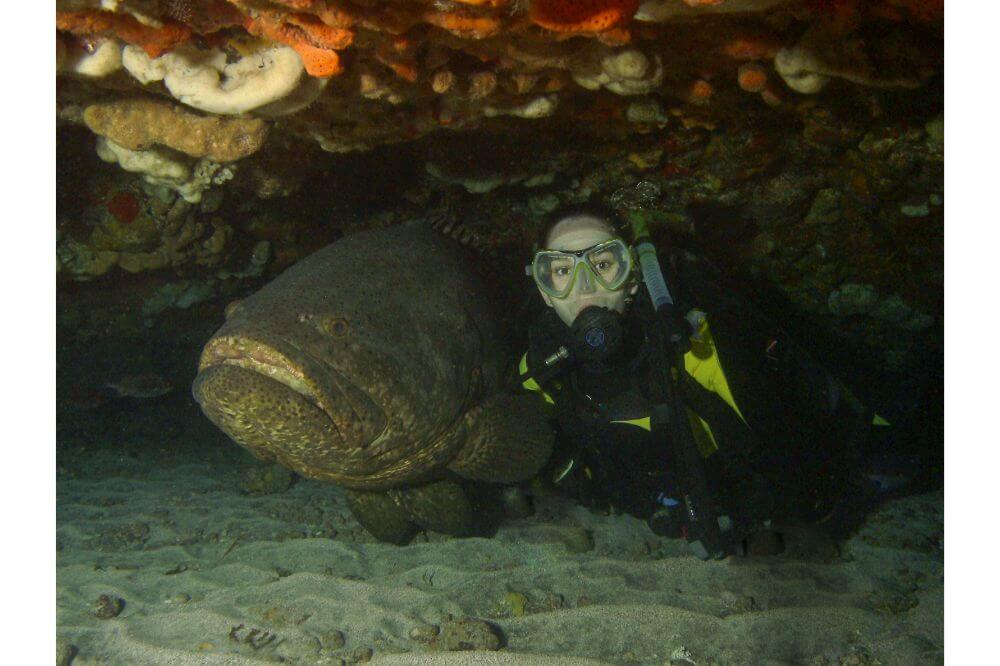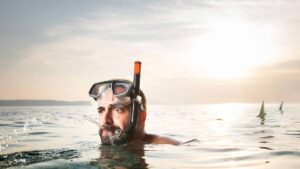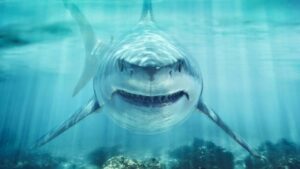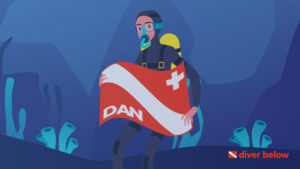If you plan on scuba diving, one fish species you want to add to your bucket list of fish to see is the goliath grouper, and as you can probably guess, it can get quite large.
Now, scuba diving with such large creatures can indeed be intimidating, but that said, these fish are absolutely worth seeing up close.
This article provides you with the information you need in terms of scuba diving with goliath groupers.
Contents
The Goliath Grouper: Basic Facts
The goliath grouper, also known as the Atlantic goliath grouper, is one of the largest bony fish in the world’s oceans.
This is a huge saltwater fish that can grow up to 2.5 meters or over 8 feet in length and weigh over 800 pounds.
Generally speaking, goliath groupers reside in relatively shallow waters in tropical areas and can be found as deep as 165 feet below the surface.
However, it is essential to know that although you can go scuba diving with them, you are not allowed to fish for them, particularly in the waters off of the US.
It is illegal to catch and harvest goliath groupers in US federal waters and state waters off the US coast.
This is because, at one point in the late 1980s, goliath groupers were so overfished that their populations were decimated.
This is why a ban on fishing them was created in 1990 in the US.
Where to Find Goliath Groupers
If you plan on seeing goliath groupers while scuba diving, you will need to dive in the right places.
As the name indicates, the Atlantic goliath grouper can be found in most areas of the Atlantic Ocean.
When it comes to the western side of the Atlantic Ocean, you can find Atlantic goliath groupers around the Florida Keys, the Bahamas, in most of the Caribbean, and down to the coast of Brazil.
There have also been times when goliath groupers have been found as far north as Maine and Massachusetts.
Along the eastern side of the Atlantic Ocean, goliath groupers can be found between Congo and Senegal.
Generally speaking, goliath groupers prefer shallower waters and can be found at depths between 16 and 165 feet.
However, they usually prefer to stick to the shallower end of that spectrum.
Moreover, although goliath groupers are large fish and adept hunters, they really don’t favor open water.
Therefore, they are usually always found in or around shallow tropical coral reefs.

Best Times of Year to See Goliath Grouper When Scuba Diving
If you want to see goliath groupers while scuba diving, you need to be in the right place and also scuba diving during the right time of the year.
When it comes to scuba diving off of the southern coast of the US, to see sharks, to go in winter; if you want to see sea turtles, go in the late spring and early summer; and if you want to see goliath groupers, go between August and October, with mid-September being peak season for goliath grouper sightings.
This is the time of year when these fish gather in huge numbers to spawn.
Therefore, if you plan on seeing goliath groupers and their mating rituals, then doing so off of the Florida Keys during September is the best time to do so.
Are Goliath Groupers Dangerous to Humans?
The simple reality is that these 10 foot long and 800 pound fish can have up to four rows of razor-sharp teeth they use to eat their prey.
However, there have been some accounts of goliath groupers stalking and attacking humans, although these stalkings are usually always unsuccessful.
That said, instances of goliath groupers actively hunting for humans are very rare.
For the most part, they are relatively peaceful fish when it comes to humans and will actually let you swim close and even touch them.
Although there are no official cases of death by goliath grouper, stories of it have occurred in the past.
Some Tips and Precautions when Diving with Goliath Groupers
When diving with goliath groupers, the main thing to remember is to swim very slowly and not make any sudden movements, or else you may spook them.
Other than that, there is not much you need to know about diving with these usually peaceful and somewhat frightful fish.
Wrapping Up
Although goliath groupers may look intimidating due to their size, the reality is that they are generally harmless to humans.
However, if you plan to go scuba diving, we hope you see some goliath groupers because they are definitely a sight to behold.





